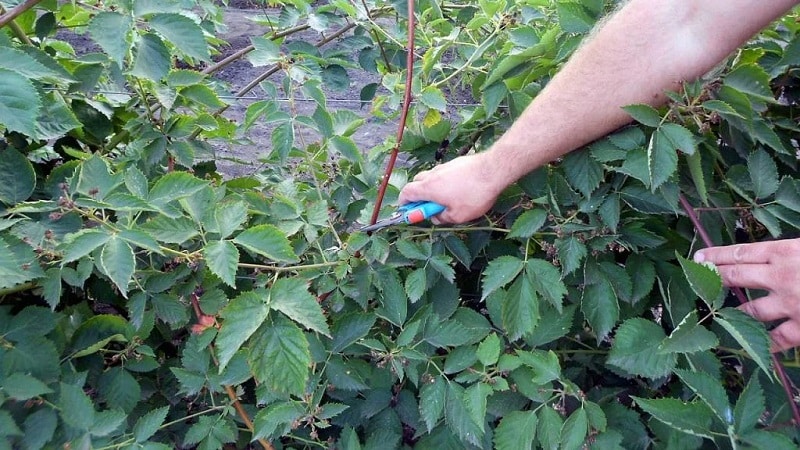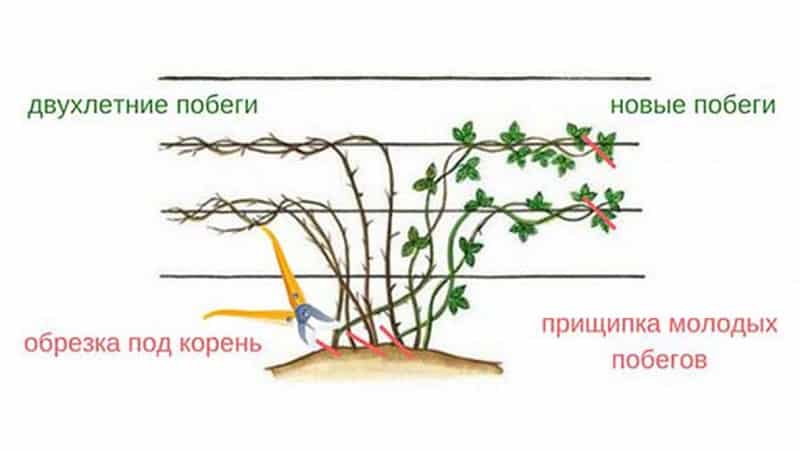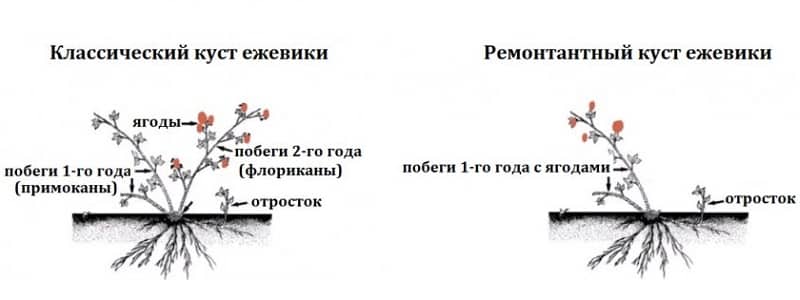How to properly prune blackberries in summer: instructions and diagrams
Pruning blackberries is not the most pleasant task. But without performing this procedure, the gardener risks being left without healthy bushes and crops. Pruning is done in the summer after fruiting has ended. Schemes and recommendations are proposed in this article.
Why prune blackberries in summer?
Blackberries resemble raspberries in appearance and characteristics. It grows quickly and abundantly.
Too thick green mass causes white spotting and rust., didimella, anthracnose.
Is this necessary?
Summer pruning of blackberries is a mandatory procedure for gardeners who want to get a rich harvest. At the same time, the treated bushes acquire a well-groomed appearance and strong immunity.

Trimming functions
The procedure is beneficial for plants. Her the main advantages are the following points:
- Blackberries are shrubs with a two-year development cycle. The shoots begin to bear fruit in the second year, and then become useless. They must be removed to prevent thickening and the appearance of pests and diseases.
- Old branches are eliminated because they provoke the development of infections and take away strength and nutritious juices from young shoots.
- In addition to forming the upper part of the bush, experienced gardeners get rid of root growth. In abundance, young plants cover the top layer of soil and prevent sunlight from penetrating between the bushes. The soil does not dry out, rot and disease appear.
- During fruiting, pruning is necessary to prepare blackberries for wintering.
Formed bushes absorb nutrients better and overwinter, correctly distribute the load, form more ovaries next year.
Timing for summer pruning of blackberries
The recommended time for pruning garden berries is the end of fruiting.
The period also depends on the variety. For example, Natchez and Ouachita blackberries are processed in the summer, while Texas and Oregon Thornless are processed in the fall.
The climatic features of the region are also taken into account:
- in the northern regions the procedure is performed in August;
- in the middle zone and the Volga region - from mid-August to early September;
- in the southern regions - in September, early October.
Favorable days
According to the lunar calendar, favorable days are considered July 25-27, August 6-8 and 16-20, September 4-6.
Interesting things on the site:
Preparation
Preparatory stage - pinching the tops. Blackberry vines stretch over 5 m in length. The tops gradually bend towards the ground and quickly take root. Without proper attention, plantings become impenetrable thickets.
Experienced gardeners It is recommended to promptly shorten and tie up branches. Pinching young shoots helps stimulate branching. Healthy branches will form before autumn, and next summer each of them will produce a large number of berries.
Some recommendations:
- the tops are pinched at a convenient height;
- blackberries are tied horizontally, like grapes;
- the next shoots are pinched so that 4-5 leaves remain on them;
- the side branches are left untouched.
In the middle zone and Siberia, it is better not to do preparatory pinching of one-year-old blackberries. The branches need time to grow, set fruit buds, become woody, and summers in these regions are short.
Advice! After a year, the full pruning procedure begins.
How to prune blackberries correctly
Full pruning begins in the second year of plant formation.. The quality and quantity of the harvest and the health of the bush will depend on the correctness of its implementation.

Required materials and tools
To work you will need sharp pruning shears, gloves, garters. The thorny shoots damage your hands, so use thick fabric gloves.
The pruning shears are pre-treated in a weak solution of potassium permanganate. Garters are necessary to secure the branches to the support.
Step-by-step instruction
Procedure:
- The shoots are carefully tied to the support. This will give them access to the right places.
- Dry, diseased shoots are removed with pruning shears. Shorten them to the ground. Do not leave broken, weak branches - they will not form anyway, they will only get in the way.
- At the same time, the root shoots are removed.
- At the end, long shoots that grow in a chaotic manner are cut off.
- 4-6 fruiting branches are left on one bush.
- Additionally, the tops are formed so that the blackberries acquire a compact and well-groomed appearance.
Mistakes to Avoid
Beginners leave stumps after removing shoots. They often become a haven for blackberry aphids, spider mites, stem gall midges, and various caterpillars. The activity of pests leads to the appearance of white spot, rust, didimella, and anthracnose.
Another mistake is to break off thick branches with your hands.that cannot be cut with pruning shears. In this case, it is better to use a sharp saw. Cut out the stems carefully, at right angles. It is good if the lower part of the branch is hidden in the ground.
Read also:
How and when to prune raspberries in the summer after fruiting
Instructions for propagating raspberries in summer by cuttings
Blackberry pruning schemes
Gardeners grow 4 types of blackberries: erect, creeping, remontant, thornless. The pruning pattern depends on the variety.
For upright varieties
Blackberries have fragile stems. They practically do not bend. Any careless movement will lead to damage to the crown.
Pruning Tips:
- the procedure is performed after the end of fruiting;
- remove all straight shoots that formed berries this year;
- cut off weak branches, leaving 9-10 of the strongest and healthiest.
If the blackberry belongs to the covering varieties, after pruning it is protected from frost. To do this, the vines are wrapped in spunbond and lightly leaned against the ground.
For creeping varieties
This blackberry is distinguished by flexible, long stems. They grow up to 10 m, so special supports are installed for convenience.
Prune after fruiting, taking into account the following tips:
- branches are completely removed from the right side;
- 10 strong shoots are left on the left, and the rest are eliminated;
- make trenches along the bushes;
- The vines are removed from the trellises, placed in ditches, and covered with warm material.
For remontant varieties
These varieties are considered the easiest to prune. In blackberries, only shoots of the current year bear fruit, so after harvesting they are completely cut out. Cover the root part with agrofibre.

For thornless varieties
These are new varieties with smooth branches. Formed from side shoots.
Trim deformed, weak, dry stems. Leave about 7 healthy ones. They are wrapped in warm protective material and slightly tilted towards the ground.
Features of pruning young and old blackberries
Basic recommendations:
- Young bushes are shortened by 10-15 cm. Next season, blackberries will reward you with abundant flowering and fruiting. If most of the stems are cut off, the bush will die in winter.
- Mature plants require the removal of old, broken, diseased, damaged shoots. If they remain, the bush will weaken and become sick.
Beginners often delay pruning, believing that there is still time before winter. But young bushes, pruned shortly before frost, do not have time to grow stronger and die in winter.
Care after pruning
Blackberries do not require special care. It is saturated with moisture by pouring up to 3 liters of water under each bush. Do not allow excess moisture, otherwise the root system will rot and die.
Feeding the plant nitroammophoska, containing 16% nitrogen, phosphorus, potassium. After watering and loosening the soil, dissolve 20 g of the drug in 10 liters of water and pour 200 ml under each root.
Be sure to remove shoots and weeds. Inspect the berry garden for pests. When they are detected, they begin an immediate fight using chemical or folk remedies.
Advice from experienced gardeners
To avoid irreparable mistakes when pruning blackberries, experienced gardeners recommend that beginners follow simple but effective rules:
- Leave 4-6 fruiting branches on one bush. Trim the tops to keep the berry garden looking well-groomed.
- In the first year, remove the top and side shoots of the plant, leaving a height of 25-30 cm from the soil surface.
- In the second year, perform sanitary pruning, additionally pinching out the buds on the side branches.
- In the third year, shorten the top of the side stems by 40 cm.
- On the fourth day, separate young branches from fruit-bearing ones by performing fan or wave pruning.
- Do not leave stumps, otherwise they will become sources of pests and diseases.
- Avoid dense thickets. Remove growth in a timely manner.
- Properly prepare blackberries for wintering.
Conclusion
Pruning blackberries in summer is a mandatory process that requires care, accuracy and compliance with all recommendations of experienced gardeners.
Be sure to take into account the varietal characteristics of the grown shrub and its age. Use only clean, sharp tools. For the beauty of the berry garden, various methods of gartering are used.